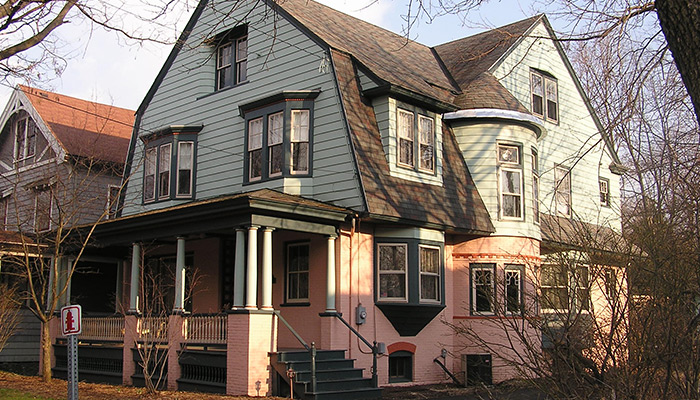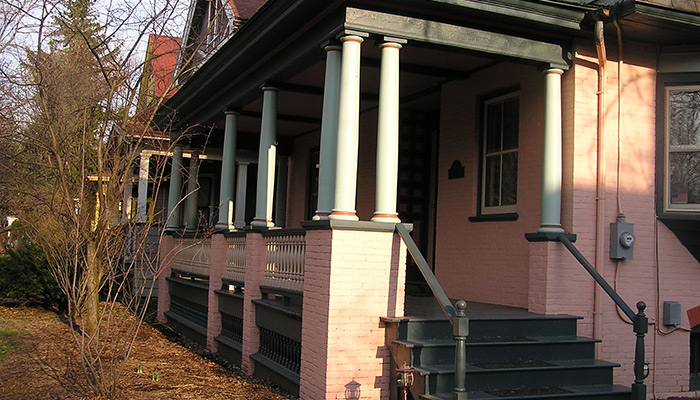This impressive house is architecturally a mixture of Dutch Colonial and Queen Anne styles mixing Dutch gambrel roof, porch with classical columns, Queen Anne semi-circular tower, bay windows, and curved interior walls. It was built ca. 1900, and a 1910 notice of sale states that it was built “on original colonial lines. First story is of cream-colored pressed brick and the second story of weather-stained shingles. The trim is quality-quartered white oak, furniture finish. A special feature is the reception hall, with its wide oak staircase, leading up to a large balcony landing, lighted by an immense dome of cathedral glass. Under this landing is a circular den with paneled wainscoting and low French window seats. The second story has five large sleeping rooms and a complete tile bathroom, with porcelain sanitary plumbing.”
The first owner to live in the house for a substantial period of time was Arthur H. Marsher, vice-president of Syracuse Faucet and Valve, who lived here from December 1902 through 1909. The next owner, George C. Larned, added to the value of the property through expansion and new construction. In July 1910, he acquired the house and the adjoining lot, completing a frontage of 88 feet, where he planned to construct a garage along colonial lines to match the exterior of the house. The garage was built in time to accommodate the next owner, Jesse L Oberdorfer, who purchased the house in April, 1912 and lived there through 1919. A 1914 ad for a “competent girl for general housework” suggests that her duties may not have been especially heavy, since there were only “two in family.”
City directories for 1921-1924 list Gottlieb G. Miller as the occupant. Thetis (?) Maxine, the daughter of the Millers, was married here in 1922. Mrs. Miller was active in the Onondaga Hospital Auxiliary; charity events for the benefit of the auxiliary were held at the house in January and March of 1923. From 1924 to 1946, the house served as parsonage or manse for Park Central Presbyterian Church and was tax-exempt during this time. The Rev. Dr. Walter Rockwood Ferris and their daughter Muriel lived here from 1924-1928, followed by the Rev. Dr. and Mrs. Ray Freeman Jenney and their daughters Lois and Eleanor from 1929-1942. Many social events associated with Park Central were held at the house during the Jenney’s time here—open houses and teas for church groups, and holiday gatherings for university students. The Rev. Norman E. Nygaard (city directory for 1944 lists name as Nygard) and his wife were the last pastoral family in residence at 116 Concord. In 1945, the Park Central Presbyterian Society sold the property. The next long-term tenants were William and Gertrude Cobb, who with their children Carol and Robert, lived here from 1946 through 1969. Mr. Cobb was a 1928 graduate of SU and a veteran of World War II (lieutenant colonel). His expertise was in the management of industrial relations. He worked in that capacity for 10 years for Aircooled Motors and then in 1961 was named Industrial Relations Director of the Manufacturers Association of Syracuse.

